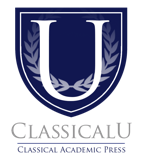Back to Course
Orientation in Classical Education: Foundations, History & Effective Teaching
0% Complete
0/0 Steps
-
INTRODUCTION TO CLASSICAL EDUCATION
Lecture 1: A Clear Definition of Classical Education5 Topics|1 Quiz -
Lecture 2: Clear Words for Classical Education4 Topics|1 Quiz
-
Lecture 3: To What Shall I Compare Classical Education?3 Topics|1 Quiz
-
Lecture 4: Various Models of Classical Education2 Topics|1 Quiz
-
Lecture 5: The Major Elements of Classical Education3 Topics|1 Quiz
-
Lecture 6: Tracing the History of Classical Education (part one)4 Topics|1 Quiz
-
Lecture 7: Why Classical Education?4 Topics|1 Quiz
-
Lecture 8: Communal Education (Paideia)4 Topics|1 Quiz
-
Lecture 9: Implementing Classical Education5 Topics|1 Quiz
-
A BRIEF HISTORY OF CLASSICAL EDUCATIONLecture 10: Classical and Medieval Ideas of Leisure and Learning3 Topics|1 Quiz
-
Lecture 11: The History of American Education4 Topics|1 Quiz
-
Lecture 12: Education in the Medieval World4 Topics|1 Quiz
-
Lecture 13: The History of Ancient Education3 Topics|1 Quiz
-
ESSENTIALS OF EFFECTIVE TEACHINGLecture 14: Foundational Principles4 Topics|1 Quiz
-
Lecture 15: Aiming at Human Flourishing4 Topics|1 Quiz
-
Lecture 16: Meaningful Planning4 Topics|1 Quiz
-
Lecture 17: Meaningful Assignments4 Topics|1 Quiz
-
Lecture 18: Meaningful Assessments4 Topics|1 Quiz
-
Lecture 19: Meaningful and Effective Classrooms4 Topics|1 Quiz
-
THE SEVEN LIBERAL ARTSLecture 20: The Seven Liberating Arts3 Topics|1 Quiz
-
Lecture 21: The History of the Seven Liberal Arts3 Topics|1 Quiz
Lesson 15,
Topic 2
In Progress
Discussion Questions
Lesson Progress
0% Complete
- How can an instructor properly balance or order the three types of goals (ultimate, intermediate, and immediate)?
- How will this look different from, say, a public school classroom?
- When students ask why they need to learn something, what sort of answer would be best to give (if it is not right to say something like “It will be on the test”)?
- What should your classroom look like in order to work toward the formation of your students? What would you hang on the walls?


